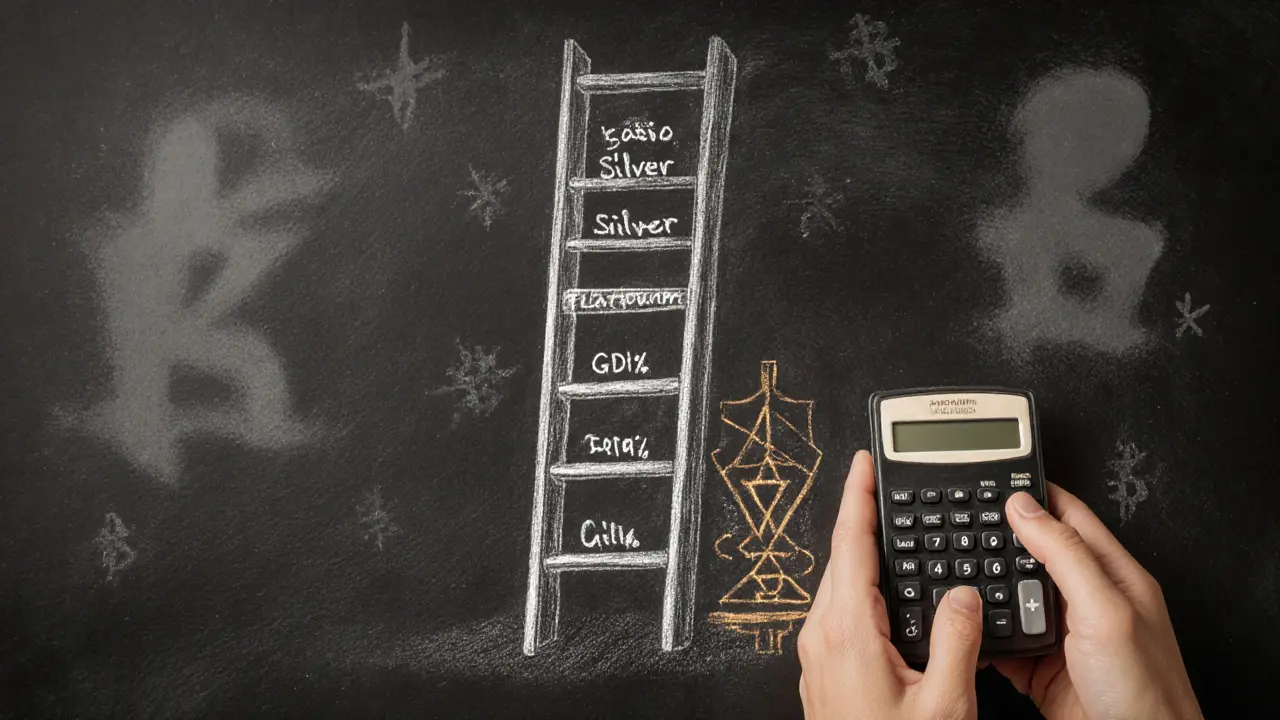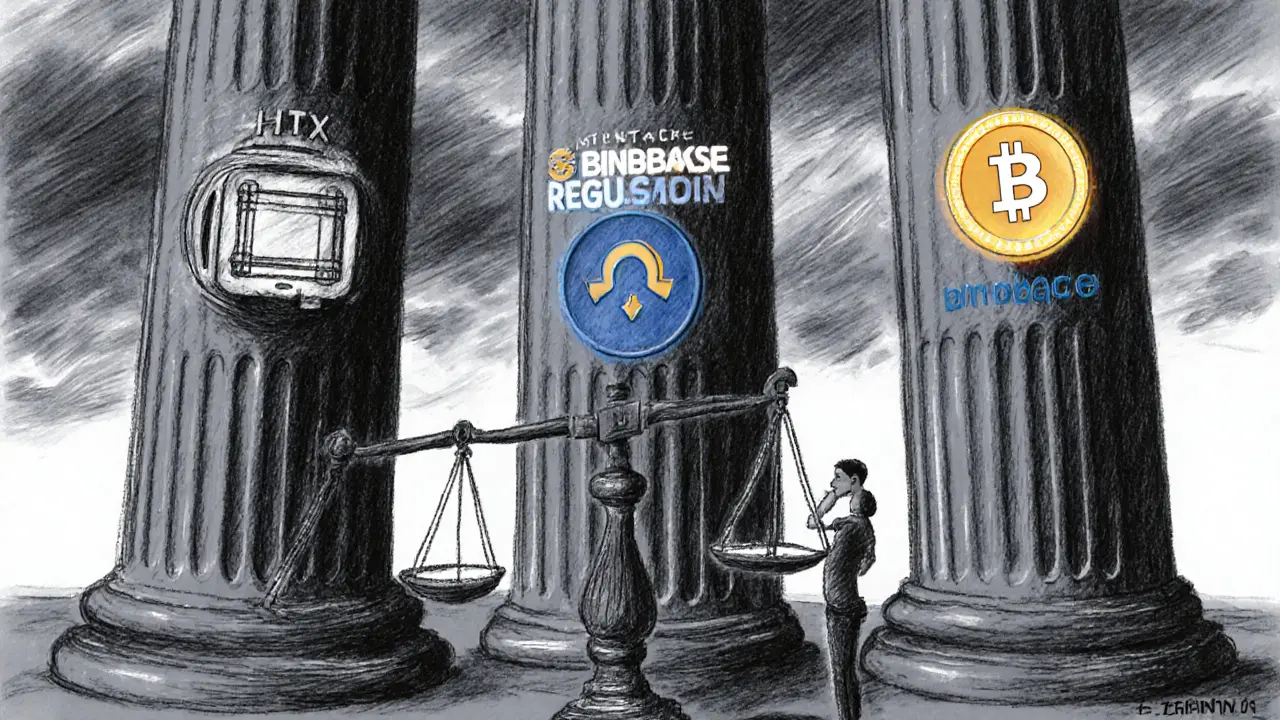HTX Fee Calculator for Argentine Traders
Trading Volume Input
Estimate your monthly trading volume to calculate your potential maker/taker fees on HTX.
Your Estimated HTX Trading Fees
HTX Fee Structure (2025)
| Tier | 30-Day Trading Volume (USD) | Maker Fee | Taker Fee |
|---|---|---|---|
| Basic | 0 - 50K | 0.20% | 0.20% |
| Silver | 50K - 500K | 0.15% | 0.18% |
| Gold | 500K - 5M | 0.10% | 0.15% |
| Platinum | 5M - 20M | 0.05% | 0.10% |
| Diamond | > 20M | 0.0126% | 0.02% |
HTX vs. Binance vs. Coinbase Comparison (2025)
| Feature | HTX (Huobi) | Binance | Coinbase |
|---|---|---|---|
| Supported Assets | 700+ coins | 600+ coins | 200+ coins |
| Daily Volume (USD) | $4B+ | $22B+ | $1.2B+ |
| Base Spot Fee | 0.20% | 0.10% (0.075% BNB) | 0.50% |
| Fiat on-ramp (ARS) | None officially | Limited via third-party | Supported via local partners |
| Mobile App Rating | 4.3/5 | 4.6/5 | 4.5/5 |
| Security Audits | Quarterly proof-of-reserves | Annual third-party audit | Regular SOC-2 reports |
If you’re scrolling through crypto exchanges looking for a platform that works for Argentine traders, you’ve probably wondered whether Huobi Argentina lives up to the hype. This review unpacks the global HTX brand (formerly Huobi), its fee structure, security record, and the practicalities of using it from Argentina in 2025.
Quick Takeaways
- HTX operates in over 160 countries, but its official status in Argentina remains unclear.
- Spot‑trading fees start at 0.2% and can drop below 0.02% for high‑volume users.
- Security features include cold storage, Merkle‑tree proof of reserves, and a transparent breach‑compensation policy.
- Mobile and desktop interfaces are praised for simplicity; Spanish support is limited to community channels.
- Compared to Binance and Coinbase, HTX offers more assets but fewer local payment options for Argentine pesos.
What Is Huobi (Now HTX)?
Huobi HTX is a cryptocurrency exchange founded in 2013 by LeonLi, a former Oracle engineer, and JunDu in Beijing. The platform rebranded to HTX in September2023 to mark its 10th anniversary and now lists its headquarters in the Seychelles. By March2025 the exchange reports more than 47million registered users, daily trading volumes above $4billion, and support for over 700 digital assets across 1,000+ trading pairs.
Is HTX Available to Argentine Users?
Official documentation does not list Argentina among the restricted jurisdictions, yet the exchange’s regional page omits any mention of local payment methods, Argentine Peso (ARS) support, or a dedicated Spanish‑language help desk. In practice, Argentine traders can attempt to sign up, but they may face the following hurdles:
- Bank‑transfer options typically route through EUR, USD, or regional hubs like Brazil, requiring an extra conversion step.
- Verification (KYC) forms default to English, and live chat is only available in English or Chinese.
- Regulatory compliance with Argentina’s MiCA framework is still pending, which could affect future access.
If you encounter a “service unavailable” error, the most reliable workaround is to use a VPN to connect through a supported country, though this adds latency and may breach HTX’s terms of service.
Core Features You’ll Find on HTX
Beyond basic spot trading, HTX offers a suite of products that appeal to both beginners and seasoned traders:
- Staking for over 50 proof‑of‑stake coins, with rewards ranging from 1% to 15% APY.
- Crypto loans that let you borrow up to 50% of your collateral value.
- Margin trading with up to 5× leverage on major pairs.
- OTC desk for large‑volume institutional trades.
- Copy‑trading, allowing users to follow top performers automatically.
The platform also runs a native token, HT, which can be used to reduce fees further.

Fee Structure Explained
HTX uses a maker‑taker model with a flat 0.2% fee for both sides at the base tier. Volume‑based discounts apply as you climb the tier ladder:
| Tier | 30‑Day Trading Volume (USD) | Maker Fee | Taker Fee |
|---|---|---|---|
| Basic | 0 - 50K | 0.20% | 0.20% |
| Silver | 50K - 500K | 0.15% | 0.18% |
| Gold | 500K - 5M | 0.10% | 0.15% |
| Platinum | 5M - 20M | 0.05% | 0.10% |
| Diamond | >20M | 0.0126% | 0.02% |
In contrast, Binance and Coinbase charge 0.10% maker / 0.10% taker (or lower for BNB‑holders) and a flat 0.50% on most retail purchases, respectively. For Argentine traders who plan to move large volumes, HTX’s tiered discounts can become very competitive.
Security & Safety Record
HTX invests heavily in security. Key measures include:
- Cold wallets storing ~95% of user funds.
- Merkle‑tree proof‑of‑reserves published quarterly.
- Two‑factor authentication (2FA) and optional hardware‑token login.
The exchange has suffered two notable breaches-in 2021 and 2023-both resulting in partial fund losses. In each case HTX publicly disclosed the incident, compensated affected users, and tightened its security protocol. This transparency, while not erasing the risk, builds a degree of trust rarely seen in the sector.
HTX vs. Binance vs. Coinbase (2025 Snapshot)
| Feature | HTX (Huobi) | Binance | Coinbase |
|---|---|---|---|
| Supported Assets | 700+ coins | 600+ coins | 200+ coins |
| Daily Volume (USD) | $4B+ | $22B+ | $1.2B+ |
| Base Spot Fee | 0.20% | 0.10% (0.075% BNB) | 0.50% |
| Fiat on‑ramp (ARS) | None officially | Limited via third‑party | Supported via local partners |
| Mobile App Rating (iOS/Android) | 4.3/5 | 4.6/5 | 4.5/5 |
| Security Audits | Quarterly proof‑of‑reserves | Annual third‑party audit | Regular SOC‑2 reports |
For Argentine users, the main differentiator is fiat access. Coinbase currently partners with a few Latin‑American banks, giving it an edge for direct ARS deposits. Binance offers a workaround via third‑party providers, while HTX relies on bank transfers in USD/EUR, which may incur higher conversion fees.
User Experience from an Argentine Perspective
The HTX desktop layout mirrors a classic trading terminal: a dark theme, real‑time candlesticks, and an order‑book on the right. The mobile app replicates this UI, allowing you to switch between “Basic” and “Advanced” modes with a single tap.
Language support is a weak spot. While the platform includes a Spanish translation for static pages, the live chat and help center remain English‑only. Community forums on Reddit and Telegram host Spanish‑speaking groups that often fill the gap, but response times vary.
Customer support tickets opened from Argentina average a 48‑hour turnaround, according to user‑submitted data on Trustpilot. For urgent issues-like a withdrawal delay-users report better luck contacting the exchange via its official Twitter account.
Pros & Cons - Should Argentine Traders Choose HTX?
Pros
- Extensive asset list and advanced trading tools.
- Competitive tiered fee structure for high‑volume traders.
- Strong security posture with transparent reserve proofs.
- Active global community and regular new‑coin listings.
Cons
- Unclear regulatory standing in Argentina; no official ARS on‑ramp.
- Limited Spanish‑language support for live assistance.
- Past security breaches, albeit compensated.
- Customer service slower than Binance’s 24/7 chat.
If you prioritize asset variety and are comfortable handling fiat conversions outside the platform, HTX can be a solid choice. Otherwise, Coinbase’s local partnerships or Binance’s broader fiat gateway might offer a smoother entry point.

Frequently Asked Questions
Is Huobi (HTX) legally allowed to operate in Argentina?
HTX does not appear on any official blacklist for Argentina, but the exchange has not announced a dedicated ARS on‑ramp or local licensing. Users can technically sign up, yet they must rely on international bank transfers or third‑party services, which may conflict with Argentine financial regulations.
What are the fees for buying crypto with a credit card on HTX?
Credit‑card purchases are charged a flat 3.5% plus the standard 0.2% trading fee. The total cost can be reduced by converting the card payment to a stablecoin first, then trading on the spot market.
How does HTX ensure the safety of my funds?
The exchange stores the majority of assets in offline cold wallets, publishes quarterly Merkle‑tree proofs of reserves, and requires 2FA for all withdrawals. In the past, HTX has compensated users after security incidents and upgraded its breach‑response protocol.
Can I trade Argentine Peso (ARS) directly on HTX?
No. HTX currently only supports fiat deposits in USD, EUR, and a handful of other major currencies. Argentine users must convert ARS to one of these currencies via a bank or an exchange that offers an ARS‑USD corridor.
Does HTX offer staking for popular coins like ETH and ADA?
Yes. HTX provides staking for Ethereum, Cardano, Solana, Polkadot and many other PoS networks. Staking rewards vary; for ETH they range around 4‑5% APY, while ADA can reach up to 7%.


Reading through this HTX review feels like watching a magician pull a rabbit out of a hat that’s already filled with rabbits. The author spends way too much time glorifying the fee tiers as if they’re a holy grail, ignoring the fact that most Argentine traders never hit those volumes. They mention a “proof‑of‑reserves” audit, yet fail to explain how a quarterly Merkle‑tree actually protects users in a jurisdiction with shaky regulation. The UX praise is blind; the interface may look slick, but the lack of ARS on‑ramps makes it a nightmare for locals. Security is lauded, but remember HTX suffered two breaches in the last few years – a bit of “we’re transparent” isn’t enough. The comparison table oddly places Binance’s BNB discount side‑by‑side with an exchange that doesn’t even support the local fiat. The article glosses over KYC pain, noting only that forms are in English, yet many Argentines struggle with that. While staking is highlighted, the APYs listed are volatile and could evaporate overnight. The mention of a “community Telegram” as support is a half‑hearted excuse for non‑existent official help. Overall the piece reads like marketing copy, not a critical analysis of whether HTX truly serves Argentine users. It would have been more useful to include concrete steps for converting ARS to USD safely. The lack of real‑world user anecdotes makes the review feel hollow. In short, the author sells HTX without addressing its biggest flaw: the missing local fiat gateway. It’s a cautionary tale of hype over substance. If you’re looking for a platform that actually works for Argentines, you might be better off with Coinbase or a local exchange that supports ARS directly.
Great breakdown! I appreciate the balanced view on fees versus actual usability for Argentine traders. The tiered fee structure really shines for high‑volume users, and it’s good to see the security details up front. Even though the fiat on‑ramp is lacking, the platform’s asset variety is a strong point. Thanks for the clear tables – they make comparison easy.
Nice work on the review! 😊 I like that you called out the missing ARS support – that’s a deal‑breaker for many here. The fee ladder looks solid, especially if you’re trading large volumes; the Diamond tier is practically free. Security-wise, the cold‑wallet ratio and proof‑of‑reserves are reassuring, though the past breaches are a reminder to stay vigilant. The UI screenshots were helpful; the dark theme is easy on the eyes. Also, the staking options on HTX are pretty diverse – I’ve seen good yields on ETH and ADA. Just a heads‑up: the English‑only live chat can be frustrating if you’re not fluent. Overall, a decent platform if you can handle the fiat conversion hassle. 👍
Good overview, especially the fee tables. The lack of ARS deposits is a real pain point. Still, the asset selection is impressive. The mobile app feels smooth enough.
Honestly, this whole thing feels like a cash‑grab. They brag about fees but ignore the fact that you can’t even fund the account easily. If you’re Argentinian, look elsewhere.
Hey folks, let’s keep it real – HTX can be a solid tool if you’re prepared for the extra steps. 🌟 The tiered fees reward serious traders, and the security features are on point. ⚔️ But the fiat bottleneck? That’s a hurdle you’ll have to jump through, maybe via a third‑party exchange. 🛠️ Still, the staking and copy‑trading options add nice diversification. 💡 Remember to enable 2FA and consider a hardware key for withdrawals. 🚀 Stay sharp and happy trading!
What a roller‑coaster of details! The author paints HTX as the next crypto Eden, yet the ARS dead‑end feels like a pothole. The fee tier chart is gorgeous – truly a visual masterpiece! 🎨 Security bragging about cold wallets is nice, but past hacks still echo in the shadows. The UI feels sleek, almost cinematic, but the language barrier can be a dull blade. In the end, it’s a mixed bag: dazzling features, pesky fiat roadblocks. 🌪️
Huobi is a joke for Argentine traders.
This review is a breath of fresh air in a sea of dry crypto write‑ups. I love how the author sprinkled colorful analogies – the fee tiers feel like climbing a rainbow ladder. The security section sparkles with vivid detail, making the cold‑wallet stats almost tangible. It’s great to see the comparison laid out side‑by‑side, like a buffet of choices. Even the shortcomings, like the missing ARS support, were laid out without sugar‑coating. The mention of community Telegram groups adds a human touch that many reviews miss. All in all, a well‑rounded piece that helps us make an informed decision.
Honestly, I think the whole hype around HTX is overblown. They act like they’re the best thing since sliced bread, but most Argentines can’t even fund the account. The fee discounts are nice, but if you can’t get money in, they’re meaningless. I’d rather stick with a local exchange that actually supports ARS. That’s the real win.
Upon careful examination of the presented data, it becomes evident that the fee‑tier structure, while theoretically advantageous for high‑volume participants, may not align with the typical trading patterns observed among Argentine retail investors. The comparative analysis demonstrates a clear divergence in fiat on‑ramp accessibility, wherein HTX lags behind its competitors due to the absence of direct ARS integration. Moreover, the security protocols, albeit comprehensive, must be weighed against the historical incidents of breach that have occurred within the past few years. It is advisable for potential users to consider the cost‑benefit ratio, factoring in both transaction fees and conversion expenses incurred when utilizing alternate fiat channels. The user‑experience narrative suggests a modern interface, yet language support limitations could hinder efficient resolution of support tickets. In conclusion, while HTX offers a robust suite of advanced trading functionalities, the practical limitations for the Argentine market may render alternative platforms more suitable for the average user.
Not convinced at all. It sounds like they’re just trying to sound fancy.